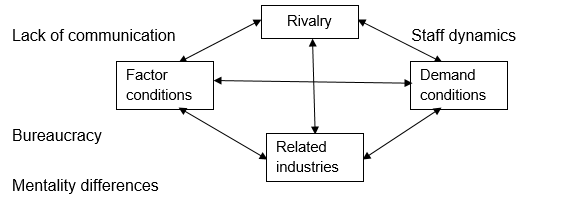Introduction
The development of the human society is based on several pillars, among which economics and business play especially notable roles. The case of Siemens AG illustrates how a globally developed company and a giant of the telecommunication market, i. e. Siemens, can also encounter developmental issues mainly caused by the inefficient communication and ignorance of important international factors for business conduct.
The analysis of the Regional Development Centers (RDCs), their international peculiarities, and associated project problems, like for example ADMOSS and Net Manager, can shed the light on the future prospects for Siemens AG. The basic frameworks for such an analysis include CAGE, Porter’s Diamond, and ADDING frameworks that allow examining the bulk of relevant aspects of strategic development issues at Siemens.
Case Analysis
Thus, starting the analysis one cannot but mention that Siemens AG was initially planned to be a global company operating in all accessible markets and offering the wide range of telecommunications products. Based on this commitment for global expansion, Siemens AG developed the set of RDCs on all continents, but the peculiarities of the local mentalities and business customs were seemingly ignored by the company’s management.
Drawing from this, the major differences between Siemens RDCs in India, Germany, and USA are all about the ability to communicate and the practices that are adopted for communication in each of the mentioned countries. The CAGE framework illustrates the point quite properly:
Thus, one can formulate the main differences among Indian, German, and U.S. RDCs as being distant in cultural and administrative aspects and having different economic environments.
The brightest examples of the differences discussed above are the ADMOSS and Net Manager projects that basically failed because of misunderstandings and different ideas held by the German and Indian RDCs regarding the fundamental of business and specific production and testing process points. Of course, the projects’ failure causes are considered through Bangalore and Munich perspectives:
Bangalore perspective

Munich perspective

Thus, the analysis of both project failures through Porter’s Diamond framework reveals that the Bangalore perspective is more focused on the bureaucracy that Indian programmers faced while trying to visit Germany for work purposes and the lack of communication in the sense attributed to it in India, i. e. open and detailed issues discussions.
On the contrary, the Munich perspective is the attempt to explain the failures from the German point of view. In more detail, Siemens officials stress the errors found in the work by Indian programmers, but also notice the lack of communication as one of the main failure causes. Accordingly, the already mentioned cultural and mentality differences do not allow finding out the single correct perspective, but the agreement of both sides about communicational issues provides background for future improvements.
In more detail, to avoid the failures and problems similar to ADMOSS and Net Manager projects, Siemens AG should reconfigure its future innovation strategy towards making it more collaborative and less subjected to bureaucratic, communicational, or distance obstacles. Thus, Siemens AG should work to add volume to its international RDCs, decrease cost and improve such points as product differentiation, industry attractiveness, and knowledge. Finally, Siemens AG should attempt to normalize risks associated with its internationally developed projects. The ADDING framework is applicable to the analysis of the recommended reconfigurations:
Thus, the above discussion and implications of Siemens AG’s experiences allow recommending that the company should implement the communication, training, and professional development policies in accordance with the ADDING framework and the best industry standards.
Conclusion
So, the discussion of the Siemens AG case allows concluding that the international expansion of business often faces cultural and communicational challenges that a company can overcome by using its internal resources and external economic and regulatory conditions. The major finding of the above analysis is the huge importance of communication and intercultural awareness for the success of various business projects carried out at least in two locations simultaneously.
